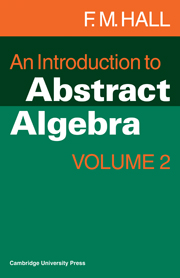2 - HOMOMORPHISMS OF GROUPS
Published online by Cambridge University Press: 12 October 2009
Summary
Mappings
This section is a brief résumé of part of chapter 9 of volume 1, and the reader who has that volume to hand should re-read the chapter in question. On the other hand, the inclusion of the material again here makes the succeeding work on homomorphisms self-contained.
A mapping is an extension of the idea of a function to general sets. The function y = f(x) associates a number y to each number x, where the ‘numbers’ x and y are usually real but may be complex, or indeed restricted to the integers or other subsets of the complex numbers. To generalise this idea, a mapping of the set A into the set B associates a unique element b (in B) to each element a in A. The sets A and B may be the same or different. For a mapping to be properly defined we must have a unique b associated with each element of A, The elements b may be all different or not, so that two or more elements of A may give rise to the same element of B. But we must not have two b's corresponding to the same a.
Notation
A is called the object space of the mapping, B is the image space, a is the object whose image is b, and we say that we have a mapping of A into B.
Information
- Type
- Chapter
- Information
- An Introduction to Abstract Algebra , pp. 29 - 55Publisher: Cambridge University PressPrint publication year: 1969
